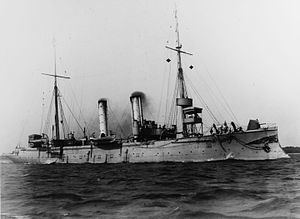Name SMS Pfeil Commissioned 25 November 1884 Fate Scrapped, 1922 Construction started 1881 | Laid down 1881 Struck 16 February 1922 Launched 16 September 1882 | |
 | ||
Builder Wilhelmshaven Imperial Shipyard | ||
SMS Pfeil was an aviso of the Imperial German Navy, the second and final member of the Blitz class. She had one sister ship, SMS Blitz. Pfeil was laid down at the Kaiserliche Werft shipyard in Wilhelmshaven in 1881, launched in September 1882, and commissioned in November 1884. Throughout her career, Pfeil served in various units in the German fleet and participated in numerous training exercises. In 1889–90, she was sent to German East Africa to assist in the suppression of a colonial revolt. In 1894–99, she was used as a fishery protection ship, and after 1904, she was used as a tender for the battle fleet. She served in this capacity until 1919. Pfeil was stricken from the naval register in February 1922 and subsequently broken up for scrap.
Contents
Design
Pfeil was 78.43 meters (257.3 ft) long overall and had a beam of 9.9 m (32 ft) and a maximum draft of 4.07 m (13.4 ft) forward. She displaced 1,486 metric tons (1,463 long tons; 1,638 short tons) at full combat load. Her propulsion system consisted of two horizontal 2-cylinder double expansion engines. Steam for the engines was provided by eight coal-fired cylindrical boilers. The ship's propulsion system provided a top speed of 15.6 kn (28.9 km/h; 18.0 mph) and a range of approximately 2,440 nautical miles (4,520 km; 2,810 mi) at 9 kn (17 km/h; 10 mph). Pfeil had a crew of 7 officers and 127 enlisted men.
As built, the ship was armed with one 12.5 cm (4.9 in) K L/23 gun placed in a pivot mount. The gun was supplied with 100 rounds of ammunition. The ship was also equipped with four 8.7 cm K L/23 guns in single mounts. Pfeil also carried one 35 cm (14 in) torpedo tube mounted in the bow. In 1891–92, the ship was rearmed with six 8.8 cm SK L/30 guns in single mounts and three 35 cm torpedo tubes, one in the bow and one on each broadside, all submerged in the hull.
Service history
Pfeil was laid down at the Kaiserliche Werft shipyard in Wilhelmshaven in 1881. She was launched on 16 September 1882, and commissioned into the German fleet on 25 November 1884. From her commissioning, she was employed as a tender for the fleet. Pfeil participated in the annual maneuvers in the summer of 1885. She was assigned to the unarmored division, along with the old sailing corvettes Stein, Olga, and Sophie. Independent division exercises took place in June, and in August, the divisions, which also included an armored division composed of several ironclads and a torpedo boat division led by Pfeil's sister ship Blitz, joined for combined fleet maneuvers that lasted until September.
In 1889, Pfeil and the unprotected cruiser Schwalbe were sent to German East Africa to participate in the suppression of local resistance to German colonial rule. By November 1890, the rebellion had been defeated and German imperial rule returned. Pfeil was the first steel-hulled, unrigged warship ever sent by Germany to its African colonies. In 1891, Pfeil served in the Training Squadron as a torpedo boat flotilla leader, along with Blitz and the aviso Jagd. During the annual summer exercises, the Training Squadron served as the hostile fleet, and conducted a mock attack on the harbor at Kiel. In early 1894, Pfeil was assigned to the I Division of the Maneuver Squadron as the dispatch vessel for the four Sachsen-class ironclads. Later that year, the ship was used for fishery protection duties. She participated in the summer fleet exercises in 1897, where she acted in the simulated hostile fleet.
Her service as a fishery protection ship lasted until 1899, when she returned to service with the fleet. She was withdrawn from active service in 1904, when she resumed her old tender duties. In 1912, Pfeil was assigned as the tender for the pre-dreadnought battleships of the II Battle Squadron. While in the II Squadron, she wore a yellow identification band on her funnel, to distinguish her from her sister Blitz, which wore a white identification stripe. She remained in her tender duties through 1919. She was stricken from the naval register on 16 February 1922 and broken up for scrap at Wilhelmshaven.
